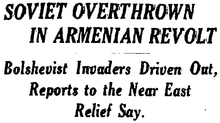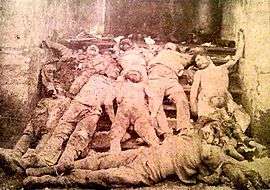February Uprising
| February Uprising | |||||||
|---|---|---|---|---|---|---|---|
| Part of Sovietization of Armenia | |||||||
 A New York Times article headline from March 17, 1921 | |||||||
| |||||||
| Belligerents | |||||||
|
|
| ||||||
| Units involved | |||||||
| Salvation Committee of the Fatherland | 11th Red Army | ||||||
| Strength | |||||||
| ~10,000 (April)[1] | unknown | ||||||
| Casualties and losses | |||||||
| unknown | 200 (in mid-April, Soviet claim)[2] | ||||||
The February Uprising (classical Armenian: Փետրուարեան ապստամբութիւն, reformed: Փետրվարյան ապստամբություն, P'etrvaryan apstambut'yun) was an anti-Bolshevik rebellion by the nationalist Armenian Revolutionary Federation which started on February 13 and was suppressed on April 2, 1921 by the recapture of Yerevan by Bolshevik forces.
Background
After the Republic of Armenia was Sovietized in December 1920 about 1,000 Armenian officers were arrested by the new Bolshevik authorities, including generals Tovmas Nazarbekian and Movses Silikyan. They were forced to walk from Yerevan to Alaverdi by foot (about 160 kilometers) and some of them were killed on the road. These officers were subsequently sent to jails in Baku and Russia. In February 1921, many heroes of the Battle of Sardarabad were shot, including Daniel Bek-Pirumyan, while his brother Poghos Bek-Pirumyan committed suicide after being tortured. Pro-ARF intellectuals were also harassed. Wheat was taken away from villagers without any compensation.
The Uprising
The repressions by the Bolshevik government of Armenia created widespread discontent and the Armenian Revolutionary Federation began a rebellion on February 13. By February 17 Ashtarak, Ejmiatsin, Garni, and Hrazdan were taken over by ARF forces. On February 18 they entered Yerevan.[3] The Bolsheviks and the Red Army retreated to Artashat. Hovhannes Katchaznouni, Levon Shant, Nikol Aghbalian and 100 other political activists and intellectuals were freed from jails.
After the capture of Yerevan, the Salvation Committee of the Fatherland was founded under the leadership of former Prime Minister Simon Vratsian,[3] which was to govern the country until the formation of a new government. The committee addressed the population on February 18 which invoked people to "protect order and rule, strictly fulfill all the orders of the committee". Throughout the 42-day rebellion, bloody battles took places between ARF forces and the Bolsheviks. On February 27 the Bolsheviks tried to attack Yerevan but on March 1 they were forced to retreat. After a two-week pause, Bolshevik units again attacked and took over Artashat on March 16 but the next day ARF forces started an offensive and recaptured the town.
The Bolshevik forces, greatly outnumbering the ARF, began a large offensive on March 24. They captured Aparan, Kotayk and gradually emerging, entered Yerevan on April 2.[4] The ARF forces retreated without any serious battle to avoid the destruction of the capital.
Aftermath

The "Salvation Committee of the Fatherland", ARF forces and many civilians retreated to Zangezur, where they joined Garegin Nzhdeh, where the Republic of Mountainous Armenia was established. It was finally taken over by Bolshevik forces in July 1921. The Armenian leaders escaped to Persia to avoid arrest and possible execution by the Bolsheviks.
The reasons of the revolt were later discussed by the Bolshevik government and was decided to treat the population with more tolerance. After suppressing the February Uprising, Aleksandr Myasnikyan was appointed Chairman of the Council of People's Commissars of Armenia, the newly installed government of the Armenian Soviet Socialist Republic.
International reactions
On February 18, the Committee send a message to the Armenian delegation in Paris and to the leaders of world powers (France, England, Italy), League of Nations, etc., but it remained unanswered. A message was also sent to the Armenian delegation in Tiflis, Georgia, where after the Sovietization of Armenia, local Armenians were subjected to violence. Georgia responded to the message on February 21, when the Armenian embassy was reopened in Tiflis. Georgia fell to the Soviets on February 25, thereafter the Armenian rebels were left alone against the Bolshevik forces in the Caucasus.
See also
- August Uprising, a similar anti-Soviet uprising in Georgia in 1924
References
- ↑ Hakobyan, Tatul (2 April 2015). "Ապրիլ 2, 1921թ. տխուր օր, որ չենք հիշում" Check
|url=value (help). aniarc.am (in Armenian). ANI Armenian Research Center. - ↑ Hakobian, A, (1986). "Փետրվարյան խռովություն 1921". Soviet Armenian Encyclopedia Volume 12 (in Armenian). p. 334.
- 1 2 Payaslian 2007, p. 170.
- ↑ Chorbajian, Mutafian & Donabedian 1994, p. 133.
Bibliography
- Chorbajian, Levon; Mutafian, Claude; Donabedian, Patrick (1994). The Caucasian Knot: The History and Geopolitics of Nagorno-Karabagh. Zed Books. ISBN 1-85649-287-7.
- Payaslian, Simon (2007). The History of Armenia. New York: Palgrave Macmillan. ISBN 978-1-4039-7467-9. External link in
|title=(help)
Further reading
- Hovsepian, Yurik (1987). "1921 թ. փետրվարյան խռովության առաջացման պատճառների նենգափոխումը հայ բուրժուական պատմագիտության մեջ [The falsification of the beginning of February, 1921 mutiny in Armenian bourgeois historiography]". Lraber Hasarakakan Gitutyunneri (in Armenian) (4): 49–55. [a Soviet-era propaganda article about the causes of the uprising]
